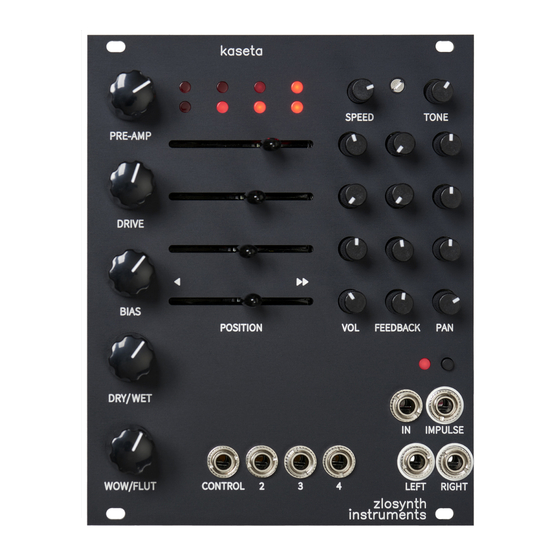
Table of Contents
Advertisement
Quick Links
MANUAL
Kaseta is a multi-purpose module inspired by reel-to-reel
tape machines. It simulates magnetic hysteresis to provide
warm saturation, its four independent delay lines can be
used to sculpt rhythms or feedback loops, and it offers
wow and flutter control. The module also goes beyond
typical tape machine features, with free-moving delays,
trigger sequencing, and an internal oscillator.
Width
20 HP
Depth
28 mm
Power
+12 V (117 mA), −12 V (8 mA)
Input impedance
100 kΩ
CV inputs
−5 to +5 V, 16-bit, 1 kHz
Trigger output
0 to +5 V, 10 ms
Audio
24-bit, 48 kHz
- Delay with 4 reading heads
- Up to 5 minutes of audio recording
- Tape saturation simulation
- Wow and flutter effects
- Tone control
- Voltage-controlled oscillator
- Trigger sequencer
- Stereo output
Advertisement
Table of Contents

Summary of Contents for zlosynth instruments Kaseta
- Page 1 MANUAL Kaseta is a multi-purpose module inspired by reel-to-reel tape machines. It simulates magnetic hysteresis to provide warm saturation, its four independent delay lines can be used to sculpt rhythms or feedback loops, and it offers wow and flutter control. The module also goes beyond typical tape machine features, with free-moving delays, trigger sequencing, and an internal oscillator.
- Page 2 Installation Mapping Kaseta is 20 HP wide. It is powered by a +12V/−12V 2×5 connector. The Each of the four multi-purpose control inputs can be mapped to any of the red stripe (−12V) has to be connected on the side of the board marked with knobs: the white line.
- Page 3 Signal flow Pre-amp Drive+Bias Dry/Wet Tone Wow/Flutter Input Saturation Filter Time effect Write Wow/Flutter Filter Tone Time effect Position N + Speed Read N Volume N + Pan N Feedback N Other heads Other heads Outputs Figure 1: The default signal flow within the module. Only a single reading head is shown for clarity.
- Page 4 Pre-amp Tone The PRE-AMP attribute attenuates or amplifies the signal received via INPUT TONE applies a filter on the saturated signal. When the pot is at its 12 between silence and +28 dB. If the input signal is boosted too hard and hours, the filter is disabled.
- Page 5 Wow and flutter Delay The module simulates two phenomena known from the physical medium: The input signal gets recorded on an imaginary tape by a writing head, to be Wow, a slow fluctuation of the playback speed, causing the pitch to move then, after a set interval, played back by a reading head.
- Page 6 Examples Some basic combinations to get you started. 13.1 Clean slate 13.2 Saturation Pass through clean unaffected signal. Saturated signal without any delay or effects. Play with the PRE-AMP, DRIVE, BIAS and DRY/WET controls to achieve the desired sound. Try different input sources.
- Page 7 13.3 Ping pong delay 13.4 Haas effect and reverb The first two heads, playing left and right with a short delay in between, The two top-most heads play the incoming signal with a delay set via model a Haas effect. This effect makes the mono input sound wide in the POSITION.
- Page 8 , and his nonlinearities for audio signal processing open-source plugin ChowTape . These materials served as the base for Kaseta’s hysteresis model. Nigel Redmon’s blog EarLevel Engineering specifically his series about oversampling mhampton’s implementation of the Ornstein- Uhlenbeck algorithm, which was used as part of the wow effect.
Need help?
Do you have a question about the Kaseta and is the answer not in the manual?
Questions and answers